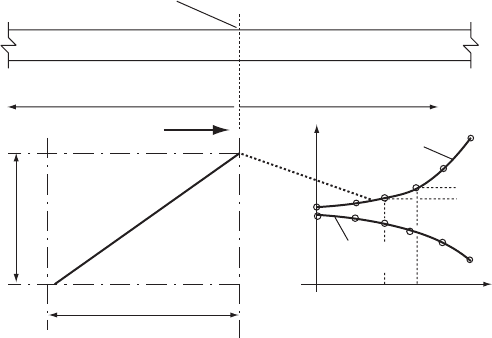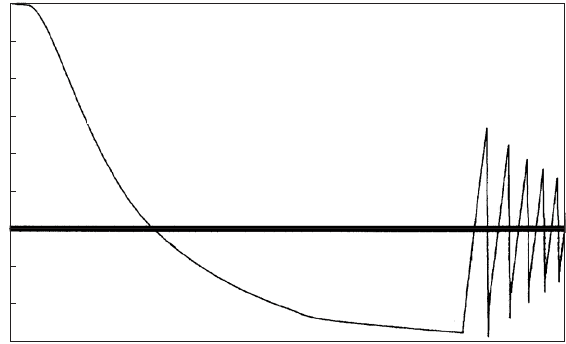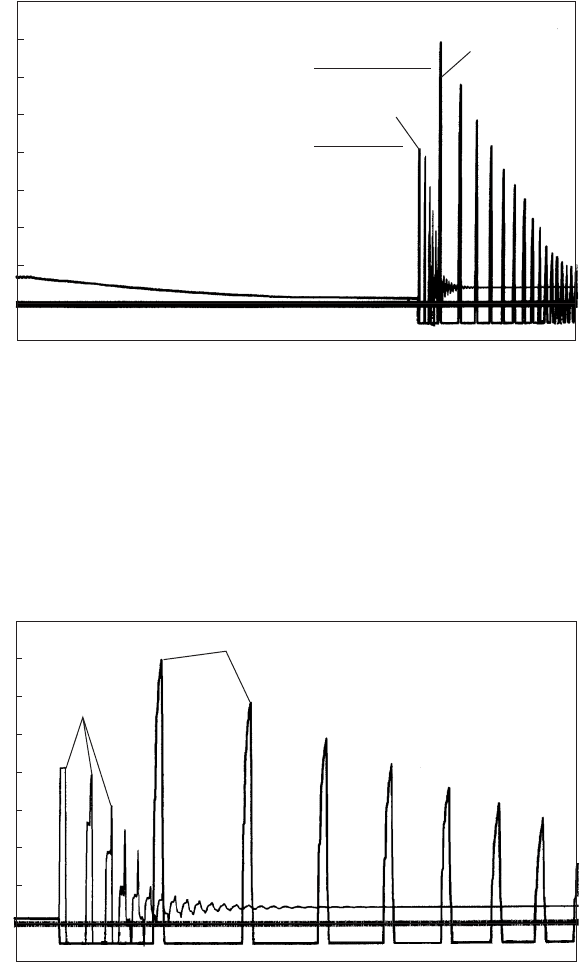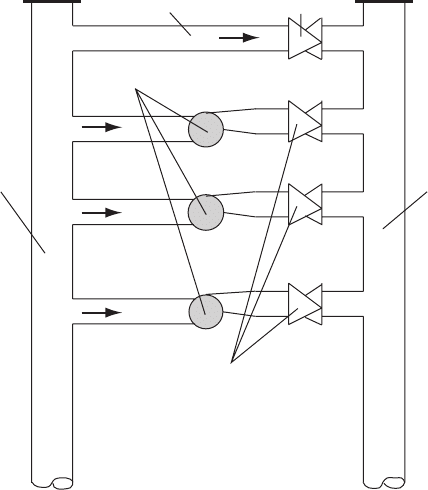Ellis,J. Pressure transients in water engineering, A guide to analysis and interpretation of behaviour
Подождите немного. Документ загружается.

time (although not necessarily at once). Along this characteristic C
s
,
while the velocity remains essentially constant, ignoring the effects of
compressibility and pipe wall deformation, head will gradually change
under the action of pipeline friction. Assuming a constant wavespeed
a, the quasi-invariant along C
s
may be written as:
J
s
¼ V
s
þ sg=aH
s
g
ð
S dt ð20:2aÞ
Representing friction gradient S using the D’arcy equation and
assuming a constant f value then:
S ¼ fV
2
s
=ð2gDÞ
or
J
s
¼ V
s
þ sg=aH
s
g
ð
fV
2
s
=ð2gDÞdt ð20:2bÞ
With reference to Fig. 20.13, over a time interval 0 to T=2, the quasi-
invariant becomes:
J
s
¼ V
s
þ sg=aH
s
fT=ð4DÞV
2
s
and
H
T=2
¼ H
s
fT=ð4DÞV
2
s
ð20:3Þ
Proceeding along the characteristic C
o
from time T=2 to a solution
point on the boundary at time T, the quasi-invariant value is:
J
o
¼ V
s
sg=aH
T=2
g
ð
S dt ð20:4Þ
with the integral evaluated between the limits T=2 and T. Applying the
D’arcy equation once more and approximating average velocity, over
the interval T=2 T,by
p
ðVV
s
Þ then:
S ¼ fVV
s
=ð2gDÞ
and at the solution point on the model boundary:
V sg=aH ¼ J
o
¼ V
s
sg=a½H
s
fT=ð4DÞV
2
s
fT=ð4DÞVV
s
or rearranging,
V½1 þ fT=ð4DÞV
s
sg=aH ¼ V
s
sg=a½H
s
fT=ð4DÞV
2
s
ð20:5Þ
From within the region being modelled the characteristic C arrives at
the solution point with a quasi-invariant value:
V þ sg=aH ¼ J
392
Pressure transients in water engineering

Adding these simultaneous equations then,
V ¼fV
s
sg=a½H
s
fT=ð4DÞV
2
s
g=½2 þ fT=ð4DÞV
s
ð20:6Þ
Substitution of this velocity value into the equation for J yields the
corresponding value of head H.
In the case of a booster pump installation it would be necessary to
incorporate two non-reflecting boundaries as illustrated in Fig. 6.13
or indeed as many such boundaries as the configuration required.
Obviously use of this technique is not restricted to pumping installa-
tions but can be applied to other circumstances. Within the pumping
station model, all of the features found in a pipeline network, such as
valves, branches, pressure vessels, air valves, may be represented.
20.8.2 System curve boundary
Where a multi-pump installation is being examined it will usually be
necessary to simulate the effects of different numbers of operating
pumps. The initial conditions require consideration of the system
curve of the downstream system and in the case of a booster pumping
station the head—flow relationship of the suction main system is also
necessary. Figure 20.14 shows the boundary of that part of the system
being modelled and the system curves which apply to a rising main
and suction main. Digitising the system curve provides the necessary
auxiliary equation to permit solution on the boundary after each incre-
ment of time. Assuming a constant wave speed a, then if conditions lie
393
i
Dx
+s
Dt
QQ
(i)
Q
(i+1)
H
(i)
H
(i+1)
H
System curve
d/s system
System curve
u/s system
Limit of modelling
Part of system being modelled External system
Fig. 20.14. Use of ‘system-curve’ as a boundary condition
Check valve dynamics
in the segment of curve between points ‘i’ and ‘i þ1’:
dH=dQ ðH
ði þ1Þ
H
ðiÞ
Þ=ðQ
ði þ1Þ
Q
ðiÞ
Þ¼H
0
or
H ¼ H
ðiÞ
þ H
0
ðAV Q
ðiÞ
Þ
and from the characteristic arriving at the boundary, the quasi-invariant J
can be written:
J ¼ V þ sg=aH
Solving for velocity then:
V ¼ðH
0
Q
ðiÞ
H
ðiÞ
þ sa=gJÞ=ðH
0
A þ sa=gÞð20:7Þ
Head H can be found by substituting the above velocity value into the
quasi-invariant relationship at the boundary.
The non-reflecting boundary may be used in tandem with the system
curve boundary to examine the effect of trip of different numbers of
operating pumps. The system curve boundary can be employed to set
up steady flow conditions for any given number of running pumps. A
subsequent computation using the non-reflecting boundary would trip
one or more of these pumps to establish the deceleration gradient
dV=dt at a failing pump. The system curve boundary can then be
used to set up a new steady flow regime for a different pumping config-
uration before using the non-reflecting boundary once more to simulate
further pump trip events.
20.9 Reduction of transient pressures following valve
closure
Pressure waves are reflected as normal from system components such as
bifurcations, vessels, etc. Since pipe lengths in the pumping station tend
to be relatively small, the period of elastic oscillations will also be short.
These pressure waves generated at the check valve will travel to the
discharge manifold or the start of the rising main. Depending upon
the relative diameters of pump branch pipes, manifold and rising
main, appreciable reduction in amplitude of oscillations can occur as
the wave travels into these components.
Two examples will be considered: a manifold or header and an
increase in pipe cross-section.
Where a manifold or header is present having cross-sectional area
A
m
and the pump branch has area A
b
then the reduction in pressure
394
Pressure transients in water engineering
head rise H
m
at the manifold can be expressed as a proportion of the
corresponding head rise H
v
at the NRV. At the instant the NRV
shuts, let the velocity in the branch be V
o
. For continuity, the flows
in the manifold must balance. Initial flow can be distributed in the
manifold in an infinite number of ways. Assume all flow comes from
the upstream side with velocity V
o
A
b
=A
m
. Flow in the other part of
the manifold is then zero. A different distribution of manifold flows
or assumption about þve flow directions will produce the same result
as the following analysis.
At a closed check valve, head rise H
v
when reversed velocity V
o
is
eliminated has often been quoted as having a maximum value:
H
v
¼ a=gV
o
This applies at the downstream valve face at initial closure and assumes
no movement of the valve longitudinally in response to thrust directed
along the axis of the pipeline. Observations have shown that it is quite
possible for maximum pressure rise in the pump branch upstream of a
check valve to exceed the value aV
o
=g. Discussion of circumstances
when this can occur is in section 20.10.
When the compression wave after check valve closure reaches the
manifold connection, head at the junction is given by:
H
m
¼ 1=g
X
ðAJÞ=
X
ðA=aÞð6:4Þ
or assuming constant wavespeed a:
H
m
¼ a=g
X
ðAJÞ=
X
A ð20:8Þ
Neglecting pipeline losses and substituting the appropriate invariant
values:
H
m
¼ a=gfA
b
ðV
o
ÞþA
m
ðV
o
A
b
=A
m
Þ0g=fA
b
þ A
m
þ A
m
g
or
H
m
¼ a=gV
o
2=ð1 þ 2A
m
=A
b
Þ
Ratio of head rise at the junction to head rise at the valve face H
m
=H
v
is:
H
m
=H
v
¼ 2=ð1 þ2A
m
=A
b
Þð20:9Þ
In the second example, when the pump branch meets a rising main
with larger diameter, then assuming a constant wavespeed a and
neglecting pipeline losses, head rise H
v
at the closed NRV is again:
H
v
¼ a=gV
o
395
Check valve dynamics

Head rise H
m
at the start of the rising main is given by:
H
m
¼ a=g
X
ðAJÞ=
X
A ð20:8Þ
Substituting the appropriate invariant values the head rise in the rising
main is:
H
m
¼ a=gV
o
fA
b
ðV
o
ÞþA
m
ðV
o
A
b
=A
m
Þg=fA
b
þ A
m
g
The ratio of head rise in the main to head rise at the NRV is then:
H
m
=H
v
¼ 2=ð1 þA
m
=A
b
Þ
or in terms of relative diameters D
b
and D
m
, the ratio is:
H
m
=H
v
¼ 2=½1 þðD
m
=D
b
Þ
2
ð20:10Þ
For example, if branch diameter is
1
2
rising main diameter then:
H
m
=H
v
¼ 0:4
Equations (20.9) and (20.10) indicate that pressure transients
produced by delayed check valve closure can be of high amplitude
but with severity decreasing quickly as the pressure wave travels into
the network. Due to the short stretches of pipework usually associated
with pumping stations, wave reflections and relief of pressure usually
occur relatively quickly so that duration of such excessive pressures
can likewise be short.
20.10 Maximum pressures at a check valve
20.10.1 Initial valve closure
When a check valve closes, the reversed velocity which has been estab-
lished is abruptly eliminated, with a corresponding head rise at the
downstream valve door face and head drop at the upstream face of
the valve. Subsequently, pressure waves propagate in both directions
from the valve. A compression wave will travel into the pipeline
system downstream of the valve and a rarefaction wave will propagate
upstream of the valve face. Local cavitation may occur at the upstream
face of the valve.
Initial closure of a valve such as a swing check is accompanied by
abrupt deceleration of the reversed velocity V
o
passing through the
valve. At the downstream face, the resulting inertial head rise H
v
is
commonly taken as:
H
v
¼ aV
o
=g
396
Pressure transients in water engineering
The value quoted above is sometimes stated as the maximum head rise
possible at a check valve on closure. This is only the case as far as the
initial head rise is concerned, as observations have revealed consider-
ably greater head rise after initial closure as described in section
20.10.2. At the upstream valve face, the corresponding head drop
will be:
H
v
¼aV
o
=g
20.10.2 Cavitation upstream of the valve and resulting peak
pressures
At the upstream valve face there is a fall in head which in the absence of
other influences will be aV
o
=g. Since pressure head H
o
at the valve
just prior to closure may be relatively low, it is quite likely that minimum
pressure at the upstream face of the valve calculated as H
o
aV
o
=g will
be less than i:l: h
vap
, where i:l: is invert level and h
vap
is the vapour
pressure head. Should minimum head reach the vapour pressure
head, a vapour-filled cavity will start to develop so that:
V
o
þ g=aH
o
¼ Jþ¼V þ g=aði:l: h
vap
Þ
Taking the cavity to be distributed across the entire pipe cross-section,
then velocity at the front of the cavity will be:
V ¼ V
o
þ g=aH
o
g=aði:l: h
vap
Þð20:11Þ
Flow in the pipe branch upstream of the valve will decelerate and
reverse becoming positive.
The cavity will then collapse with an attendant shock pressure rise
against the upstream valve face. By this time, pressure wave effects in
the pipe branch downstream of the check valve may well have dissipated.
In his investigations of 50 mm swing check valve behaviour, Worster
(1959) observed that in almost all cases studied, after initial seating of
the valve, the door repeatedly opened by a very small amount and then
shut due to the action of pressure waves in the pipe branch upstream of
the valve. The differential transient pressure across the valve door was
sufficient to reopen the valve. In more severe tests when appreciable
noise was produced by initial closure, the valve remained shut for a
longer period and then reopened sometimes by as much as 128 from
its seat. Following closure, further periods of reopening and closure
occurred. Worster attributed this behaviour to high surge pressures
after cavity closure, producing a thrust against the valve door causing
it to reopen. Forward velocity in the entire upstream water column as
397
Check valve dynamics

the cavity collapsed was of a similar order as the initial reversed velocity
at the time of initial closure.
Miller (c. 1970) observed behaviour of a Glenfield and Kennedy
Swing Check Valve subsequent to pump trip from an initial steady
pumping head of 14.33 m. Following check valve closure, a peak pres-
sure head of 405 ft or 123.44 mWG was measured at the inlet to the
check valve while the corresponding peak pressure at the valve outlet
was 270 ft or 82.3 mWG. Figure 20.15 shows predicted coastdown of
velocity at the pump discharge. After closure, the velocity oscillates
as a vapour cavity upstream of the check valve repeatedly opens and
shuts. The corresponding pressure head is shown in Fig. 20.16 together
with the observed values. A more detailed picture of head changes can
be seen in Fig. 20.17. It will be noted that head variations downstream
of the valve occur with higher frequency and dissipate more rapidly.
Modest vapour cavities were predicted to occur on the downstream
side of the valve but these were smaller and relatively short-lived
under the generally higher pressure prevailing in the downstream pipe-
line. The head changes upstream of the valve take place over a longer
time span with larger cavities forming. From this and other studies it has
been noted that transient pressures upstream of a check valve can
exceed the corresponding downstream pressures often by a considerable
margin. Changes in diameter along the pump suction and discharge
branches can aggravate conditions.
398
3
2.5
2
1.5
1
0.5
0
–0.5
–1
–1.5
0.001
0.109
0.216
0.323
0.431
0.538
0.645
0.753
0.860
0.967
1.075
1.182
1.289
1.397
1.504
1.611
1.718
1.826
1.933
2.040
2.148
2.255
2.362
2.470
2.577
2.684
2.792
2.899
3.006
3.114
3.221
Velocity (m/s)
Time (s)
Velocity at pump discharge following pump trip at time = 0.1 s
Fig. 20.15. Velocity coast-down after pump trip
Pressure transients in water engineering

The behaviour described is another instance of a cavity allowing
time for an appreciable velocity to develop whose subsequent rapid
deceleration leads to high transient pressure. Any type of cavity,
whether air-filled, gas-filled or vapour-filled, may provide time for an
399
0.001
0.121
0.240
0.359
0.478
0.597
0.716
0.835
0.954
1.073
1.192
1.311
1.430
1.549
1.668
1.788
1.907
2.026
2.145
2.264
2.383
2.502
2.620
2.700
2.858
2.977
3.096
3.216
3.394
3.4
3.5
123.44 metres – peak head
measured at valve inlet
160
140
120
100
80
60
40
20
0
–20
Pressure head (mWG)
Time
(
s
)
Pressure head at inlet and outlet of Glenfield and Kennedy Swing Check Valve
following pump trip at time = 0.1 s
Valve inlet
Valve outlet
82.3 metres – peak head
measured at valve outlet
Fig. 20.16. Head plotted against time as check valve shuts
2.570
2.596
2.623
2.649
2.675
2.792
2.728
2.755
2.781
2.808
2.834
2.861
2.887
2.914
2.940
2.967
2.993
3.019
3.046
3.072
3.099
3.125
3.152
3.178
3.205
3.231
3.258
3.264
3.311
3.367
3.383
Pressure head (mWG)
Time (s)
Detail of pressure head at inlet and outlet of Glenfield and Kennedy
Swing Check Valve following pump trip at time = 0.1 s
160
140
120
100
80
60
40
20
0
–20
Valve outlet
Valve inlet
Fig. 20.17. Head plotted against time as check valve shuts (detail)
Check valve dynamics
excessive velocity to develop with consequent pressure rise. Physical
characteristics of cavities may differ depending upon their content.
Water vapour will recondense as pressure rises above vapour pressure
with virtually no back-pressure to decelerate the developing velocity
whereas an air-filled cavity will tend to impose some deceleration on
flow as the air becomes compressed.
20.11 Other applications of check valves
20.11.1 Check valve at the start of a rising main
Check valves may be located at the start of a rising main to prevent
flooding of a pumping station in the event of a pipe burst either
within or close to the station. If a pressure vessel is present, this
check valve should be sited upstream of the vessel connection to
avoid the vessel becoming isolated from the main following valve
closure. This type of installation is more usual in higher head systems
where the effects of a discharge into the pumping station could be
more severe. A rising main check valve will usually be at least the
same diameter, and often larger, than the pump discharge check
valve. A larger valve of the same pattern in the rising main will close
more slowly than the valve at the pump discharge in the event of
pump trip but should a pipe burst occur just upstream of the large
check valve a more rapid closure will occur. Hydraulic transient
investigation of this event should be carried out to ensure that safe
closure can be achieved without incurring further severe surge effects
after the valve shuts. Consideration should also be given to the possi-
bility that a larger check valve of a light-door pattern, at the start of
a rising main, may oscillate if not held fully open by the flow.
20.11.2 Check valve on vessel connection
This valve will usually be required to open promptly in the event of
outflow from the vessel, tending to indicate a light-door valve. There
is evidence of valve stops being damaged on commencement of outflow
from the vessel, where a heavier door is thrown open against its stop.
20.11.3 Bypass check valve
A check valve may be required on a bypass line in a pumping station
(Fig. 20.18). The bypass arrangement only comes into play when the
400
Pressure transients in water engineering

head, or piezometric level, downstream of the pump(s) falls below the
suction head. The bypass check valve then opens, allowing flow to
pass through the bypass around the pumping station without having
to pass through the pump. Without this arrangement the pump will
continue to rotate, absorbing energy. This type of arrangement is
particularly useful if for example the pumps are acting to augment
gravity flow.
When pumps are tripped, piezometric level downstream of the pumps
falls below suction level and flow commences in the bypass. The check
valve should be able to open without undue delay but more importantly
should be able to close promptly in the event of pumps being restarted,
otherwise slam could occur when the check valve door finally closes and
reversed flow in the bypass is eliminated.
20.11.4 Check valves along a rising main
A further interesting application of the check valve is as a pressure
transient control device placed along a rising main. Consider a pumping
main operating at intermediate to high head, such as may produce
401
Bypass line NRV
NRV
Discharge headerSuction header
Pump
Fig. 20.18. Check valve on bypass line
Check valve dynamics
